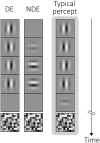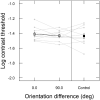Afterimage duration depends on how deeply invisible stimuli were suppressed
- PMID: 37526624
- PMCID: PMC10399604
- DOI: 10.1167/jov.23.8.1
Afterimage duration depends on how deeply invisible stimuli were suppressed
Abstract
Quantifying visual responses to stimuli that are outside of awareness is a critical task for the study of visual consciousness. The current study psychophysically investigated whether afterimages reflect visual responses to stimuli that are not consciously visible throughout adaptation due to interocular suppression. A Gabor adaptor was presented to one eye of the observer, and a counterphase-flickering Gabor suppressor was presented to the other eye, thereby rendering the adaptor invisible during adaptation. To manipulate the depth of the suppression of the invisible adaptor, we varied the orientation difference between the adaptor and suppressor. We found that, even though the adaptor was not visible during adaptation, the afterimage duration varied depending on the orientation selectivity of interocular suppression. The duration was the shortest when the orientations of the adaptor and suppressor were identical and lengthened when the orientation differences increased. This finding could not be explained by confounding factors such as potential changes in contrast sensitivity that were caused by the suppressor. Our findings suggest that the magnitude of visual responses to stimuli suppressed below the threshold of awareness can be measured using the afterimage duration. Afterimages could be an effective tool for quantifying visual responses, irrespective of observers' conscious awareness of a presented stimulus.
Figures






References
-
- Almeida, J., Mahon, B. Z., Zapater-Raberov, V., Dziuba, A., Cabaço, T., Marques, J. F., & Caramazza, A. (2014). Grasping with the eyes: The role of elongation in visual recognition of manipulable objects. Cognitive, Affective, & Behavioral Neuroscience , 14, 319–335, 10.3758/s13415-013-0208-0. - DOI - PubMed
-
- Baayen, R. H., Davidson, D. J., & Bates, D. M. (2008). Mixed-effects modeling with crossed random effects for subjects and items. Journal of Memory and Language , 59, 390–412, 10.1016/j.jml.2007.12.005. - DOI
Publication types
MeSH terms
LinkOut - more resources
Full Text Sources

